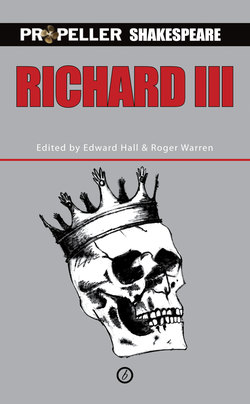Читать книгу Richard III - William Shakespeare - Страница 11
На сайте Литреса книга снята с продажи.
ОглавлениеDesigning Richard III
Designing a visual narrative for Richard III that echoes Shakespeare’s text is, in some respects, fairly straightforward. Like Macbeth, the story relies on a central character’s journey into a disturbing underworld of psychosis and ultimate self-destruction. The design can’t afford to hold up the momentum of his slide into a hell. What the play allows for is the full range of visual and physical possibilities for that journey – what is the context in which such a character can surface with such ferocity and then be conquered? Who will be responsible for creating his nemesis? How can we actually see the workings of Richard’s mind in a similarly dramatic way to the confessions and quips he makes to the audience...and should we see them?
Propeller Theatre celebrates the contribution of all performers who, in many productions, knit together as a chorus who collectively personify a subtext – the identity of this group is an intriguing design challenge. They add significantly to any image as passive voyeurs or protagonists- in-waiting half in, half outside the story. Here, we explored the internal motivations, exposed them and expanded them into a physical reality – splitting Richard’s psyche into a squad of masked, white-coated but grubby Victorian hospital orderlies that looked more comfortable in Bedlam than exposed on stage.
The logical progression of this idea was a scenic world of mobile surgical screens and a pivotal operating table that contorted into a throne, tomb or warhorse. A functional zip-up tower from a builder’s merchants became ‘the bloody Tower’ complete with a range of DIY tools of mass destruction and the whole space framed by contemporary trussing that supported the occasional use of a full-height, slashed, plastic abattoir curtain. The design was therefore more of a psychological space than any geographical location but constantly counterpointed by the anchor point for Propeller’s history cycle, an ubiquitous flagpole and cross of St George.
Richard III can at times read as a tragic-comedy as much as a warped historical commentary and it certainly plays like that on stage. It’s an entertaining sideshow of gothic horror but also a warning shot across England’s bows. If handled deftly, design has the ability to reflect the clash of themes and tones that Shakespeare composes by making references to recognisable icons that appear and evaporate hopefully before the audience loses its faith in a familiar image (cliché?) and therefore the production’s credibility. The restlessness of the history plays is a set and costume designer’s gift to make visual triggers that affirm our collective memory, and make it a fleeting but powerful reality.
Michael Pavelka
Scenic design for Richard III
